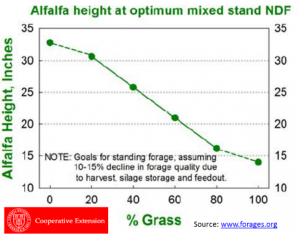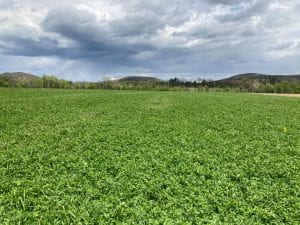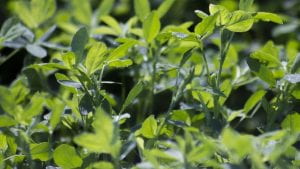This is the team’s second week of monitoring alfalfa heights for first cutting quality in 2024. The full report for our six-county region (Broome, Cayuga, Chemung, Cortland, Tioga, and Tompkins Counties) can be found in the following link: Alfalfa Height Reporting Sheet 5.14.24.
This week’s updates:
If it would stop raining for three days, I’m certain we’d see a lot of movement of hay crop heading into bunks.
That being said, many farms were able to take advantage of dry weather last week and put up winter forage. Grass quality is rapidly maturing, and there have been some attempts to start to get this crop harvested on many farms.
In general, mixed grass/alfalfa fields will be at dairy quality fiber levels this week as noted in the predictions in our table, across the region.
Broome: average alfalfa height is over 20″, gaining 5″ from last week’s measurements. Mixed alfalfa/grass fields are at peak NDF quality for dairy forage harvest.
Cayuga: average alfalfa height is just under 19″, gaining over 4″ from last week. Mixed alfalfa/grass fields will be ready for dairy quality forage harvest this week, elevation dependent.
Chemung: average alfalfa height was over 23″, gaining over 4″ from last week. Mixed alfalfa/grass fields are at peak NDF quality for dairy forage harvest, with pure alfalfa predicted to be ready for harvest next week, heat and weather dependent!
Cortland: average alfalfa heights here were 18″, gaining about 4.5″ over last week. All grass fields are at peak NDF quality for dairy forage harvest, and mixed fields are predicted to be ready within a week in many areas, elevation dependent.
Tioga: average alfalfa height here was measured at 21.5″, gaining almost 4″ over last week. Mixed alfalfa/grass fields are ready for dairy quality harvest, elevation dependent. Full alfalfa fields in some locations are already at 24-25″, and pure alfalfa fields should be harvested for peak quality at 28″ to achieve 40% NDF.
Tompkins: average alfalfa height was just under 21″, gaining 5″ over last week. Mixed alfalfa/grass fields are ready for dairy quality harvest.
Additional Information to Consider
PRO-DAIRY’s forage specialist, Joe Lawrence, shared some thought with dairy producers on this years first cutting harvest in an e-alert sent out on May 10th, which I’ll provide below in case you missed it.
Managing Forage and Spring Weather: 2024
Joe Lawrence
The region is now into the spring field season but there is still a great deal of opportunity to achieve your forage goals this spring. Weather patterns vary across the region, but frequent rain events are disrupting field work effort for many. Here are some considerations for managing these challenges.
Closely monitor first cutting hay
Don’t miss peak quality for dairy cows. 100 percent grass field are already there in many areas of the state and mixed stands will be following closely. Several CCE teams provide updates on alfalfa heights. Check with your local team for updates.
Focus on crops at your target quality
By the time this is read, the window for capturing dairy quality winter cereal (rye, triticale) forage and early perennial grasses will have past. Once this happens re-order your harvest plan and send these fields to the back of the list for non-lactating quality feed. Prioritize fields that are still at their dairy target quality for harvest.
For winter cereals past their prime on fields intended for corn planting, decisions will need to be made regarding terminating these as a green manure cover crop for timely corn planting or leaving them to harvest as non-lactating quality feed at which point an alternative to corn may be needed for the subsequent crop.
Harvest within limited weather windows
Harvest management strategies can make a significant difference in successfully capturing forage at the target quality despite weather challenges.
- Be ready and nimble.
- have harvest equipment and plan ready
- watch individual fields and seize opportunity to harvest when ready
- Wide swath – greater than 80 percent of cutter bar width.
- Cutting height – a three to four inch cutting height has numerous benefits.
- Keeps windrow up off of moist soil for better drying
- Reduces risk of soil contamination (ash)
- Reduces stress on grass forages (target four inch cutting height)
- Use of tedders and rakes – an important tool for managing harvest in small weather windows. Take care to minimize leaf loss with legumes.
Hay before corn – especially on wet soils
Guidelines around “parking the corn planter” to harvest hay at the optimum time have been common for several decades now but are still often ignored. Timely corn planting is important, but the window of opportunity is wider than first cut hay crop forages. Corn performance remains strong with planting through late May, dairy quality hay crop forage will be long gone by late May for grasses and many mixed stands.
Additional problems from the rush to plant corn result from planting into wet soils as many are experiencing now. This article on the Risk of Sidewall Compaction from Penn State is a good reminder of why it is not worth it to rush corn planting in wet field conditions.
A Reminder on our Methods
For prediction of NDF content, the height of alfalfa as an indicator is as follows:
- 100% grass stands – cut when nearby alfalfa is 14 inches tall (achieves 50% NDF)
- 50/50 grass/alfalfa stands – cut when nearby alfalfa is 22 inches tall (achieves 44% NDF)
- 100% alfalfa stands – cut when alfalfa is 28 inches tall (achieve 40% NDF)

Predicted days to cut are based on daily NDF increases for grasses of 1.0% point, 50/50 mixed alfalfa/grass stands of 0.8% points, and alfalfa of 0.5% points and are adjusted for the coming week’s weather. Typically NDF increases about 0.8 to 1.2 per day for grasses, with cooler weather being the lower end of the range and warmer weather being the higher end. For alfalfa, NDF increases about 0.4 to 0.7 per day, also dependent upon warm/cool weather.
Next Report
Look for our next report of monitoring heights to come out on Wednesday, May 22nd. In the meanwhile, if you can’t get out to check your fields, call one of us on the team. We’ll be glad to help out.


